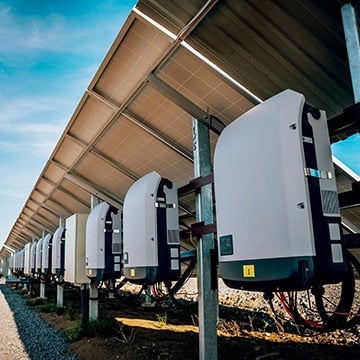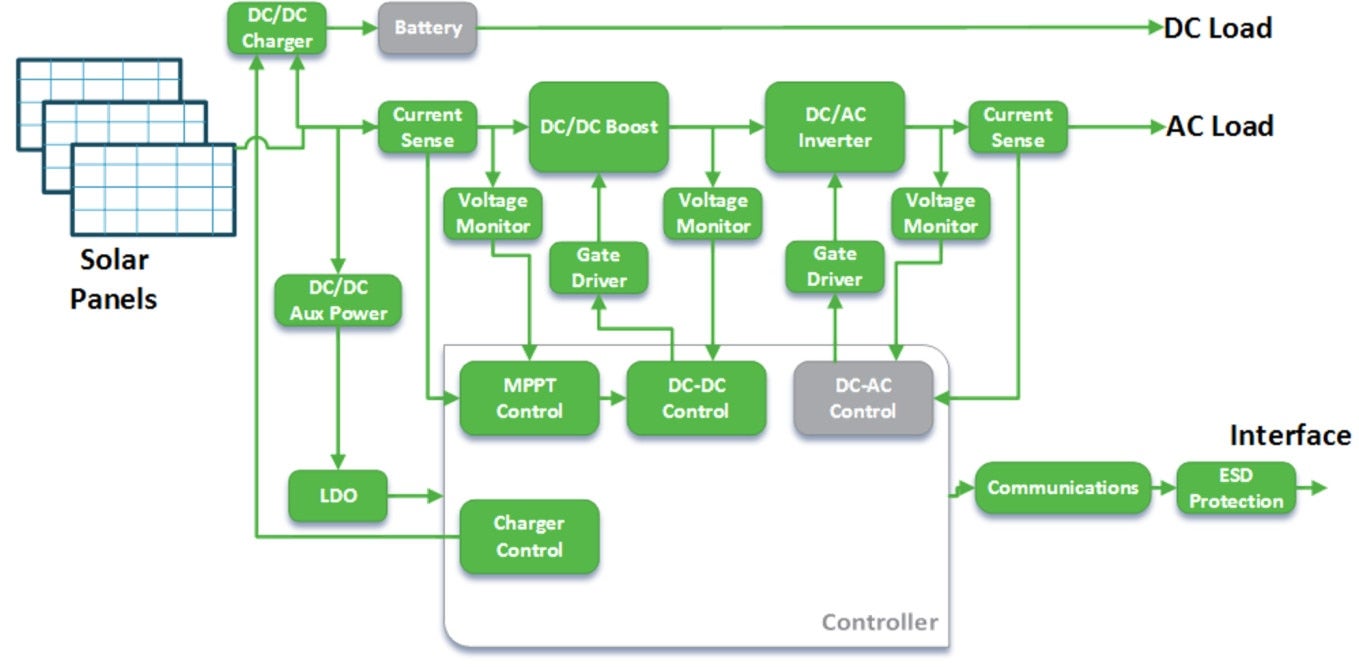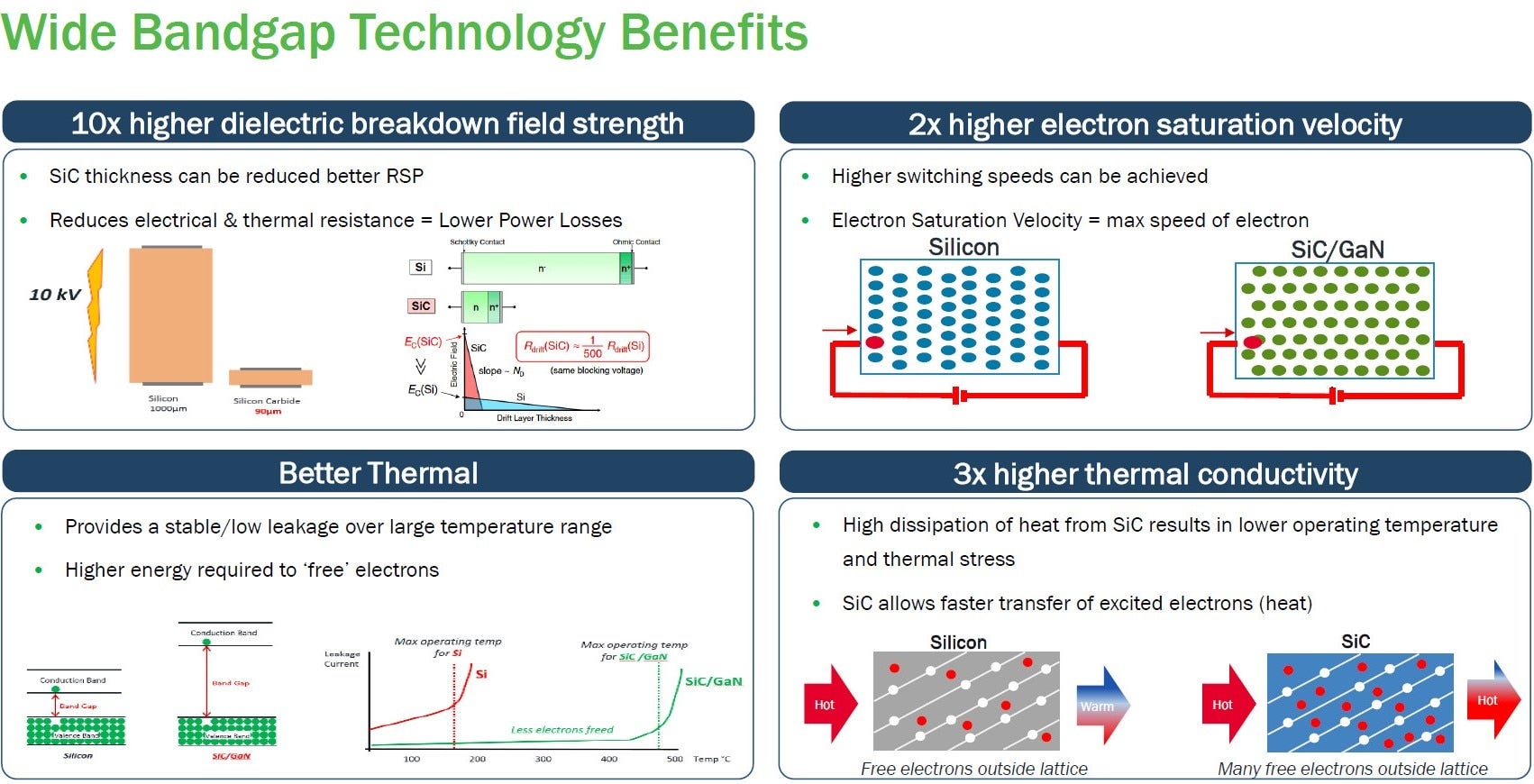We’re constantly faced with the current standing of the global climate situation - our news feeds are filled with fires, floods and wild weather, all of which are being attributed to climate change.
The situation is clearly of concern and individuals, governments and lobby groups are advocating significant reductions in fossil fuel usage – or a complete ban.
However, without appropriate technology that is able to deliver energy efficiently and at a comparable price point to existing technology, many government-backed initiatives to promote solar power are unlikely to be wholly successful.
Solar power is inherently a direct current (DC) technology that requires an inverter (DC to AC) to generate power. Once alternating current (AC) is available then all main devices can use the energy and even small installations, such as those in homes, can be connected to the grid allowing power to be shared.
Figure 1: Block diagram of a typical solar power inverter system
In the early days of solar power, inverters tended to be centralized with capacities in excess of 100 kW. However, more recently this trend has changed with operators preferring to use strings of sub-100 kW inverters. In each case, the architecture is similar to a DC/DC boost converter to increase the voltage from the PV panel and a DC/AC inverter that generates an AC voltage at the correct frequency for the local grid (50 Hz / 60 Hz). The system is completed with protection circuitry and sophisticated monitoring/control that ensures optimum efficiency is achieved at all times.
Even though the sun is an infinite source of energy, efficiency is a key consideration for solar powered systems. Any inefficient system creates unwanted heat which has to be removed from the system. Inevitably this will involve thermal management measures including heatsinks and / or fans, each of which adds size, complexity, weight and cost to the system.
While the topology chosen for the inverter will have an impact on the efficiency, the primary semiconductor switching devices (MOSFETs, IGBTs and diodes) are absolutely critical to achieving the efficiencies needed for modern solar power applications. Since semiconductor devices were invented, silicon (Si) has been the primary material used and, through years of incremental innovation, this technology has reached a point where very little further enhancement is possible.
Hence, major semiconductor manufacturers, such as ON Semiconductor, have been exploring other materials to build future switching devices from. So-called wide bandgap (WBG) materials including gallium nitride (GaN) and silicon carbide (SiC) have come to the forefront as their properties are ideally suited for developing efficient semiconductor devices.
WBG materials have inherently lower resistance than Si-based devices, reducing static losses when conducting continuously. In addition, as switching frequencies rise to reduce the size of magnetic components WBG technology further improves efficiency as the gate charge is reduced compared to silicon, reducing the dynamic losses as well.
Figure 2: Wide Bandgap Advantages
If there has been one factor slowing the adoption of WBG, it has historically been the cost. However, a cursory analysis will lead engineers to the wrong conclusion as semiconductor devices typically account for only 10% of the cost of a power system with the inductors and capacitors representing approximately 90%. Due to their enhanced performance, SiC devices allow capacitor and inductor values to be reduced by around 75%, dramatically reducing their cost and, often, the size.
Figure 3: A typical SiC diode exhibits 73% less losses than a silicon diode when operating at 80kHz
If the savings on the passive components are taken into account then, notwithstanding the higher cost of the SiC devices, the overall cost of a WBG-based power solution is now equivalent to, or slightly lower than that of a Si-based solution.
ON Semiconductor offers a large portfolio of SiC MOSFETs including 900V such as NTHL020N090SC1 and 1200V such as the NTHL040N120SC1 having an on-resistance (RDS(ON)) of just 40 mOhm, low gate charge (QG) and capacitance values that reduce EMI and permit faster switching frequencies to be used, delivering the benefits described. SiC Schottky diodes such as 650V and 1200V. An example is the 30A FFSH30120A having no reverse recovery, current and temperature independent switching characteristics which makes them ideal for use in advanced solar power applications.
As the industry has reached this key tipping point, WBG devices will truly become enablers of a bright solar-powered future, contributing to a more energy-efficient planet, combating the effects of climate change.
Learn more about Solar Inverter Solutions today, as well as how Utilizing Wide Bandgap in Solar and Renewable Energy Applications can benefit your designs!



